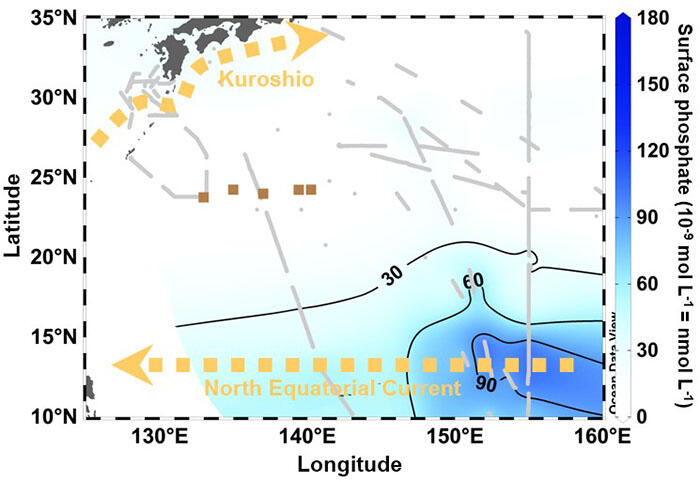Associate Professor Fuminori Hashihama, Department of Marine Environmental Sciences, Graduate School of Science, Tokyo University of Marine Science and Technology (Kaiyodai), and Professor Ichiro Yasuda, Atmosphere and Ocean Research Institute, University of Tokyo, in collaboration with the Meteorological Agency and the University of Tasmania, announced on June 8 that they identified a nutrient supply mechanism supporting bioproduction in a subtropical open ocean area (marine desert), wherein the nutrients required for surface bioproduction are extremely scarce. The supply of nitrogen and phosphorus was successfully detected through a sensitive analytical method. Phosphorus, which is supplied at only approximately 10% of its biological demand, is rapidly regenerated and circulated to facilitate bioproduction This result is expected to contribute to the healthy maintenance and sustained bioproduction of the ocean and was published in the American scientific journal Nature Communications.
Subtropical oceans are called "marine deserts" because they are characterized by ultra-oligotrophic water wherein the concentration of nutrients required for surface bioproduction is below the limit of detection of conventional analytical methods. However, these areas exhibit active bioproduction. Due to this phenomenon, the nutrient supply mechanism in these areas was unclear. The researchers conducted time-series observations of the North Pacific western subtropical at a latitude of 24 degrees north to investigate the nutrient supply mechanism supporting bioproduction by utilizing the latest high-sensitivity nitrogen and phosphorus analysis techniques.
The observations were conducted via the Japan Meteorological Agency (JMA) observation vessels "Hibiki" and "Keiko." The scientific survey, which measured nitrogen and phosphorus and other parameters, was carried out at five locations 500 km from Japan via 13 observation voyages between 2014 and 2019. The researchers successfully captured the seasonal variation of nanomolar levels of nitrogen and phosphorus. In particular, they clarified that the nutrient supply from deeper layers reaches the surface during low-temperature periods, when the temperature dips below 28 °C. They also utilized long-term data on nitrogen and phosphorus deposition and nitrogen fixation from the atmosphere in the subtropical North Pacific Ocean to examine the annual nitrogen and phosphorus supply at the surface layer, from 0-100 m below the surface, where phytoplankton photosynthesis occurs, along with the understory supply. The nitrogen and phosphorus supply that facilitates bioproduction is also supported by atmospheric aerosol deposition and biological nitrogen fixation in addition to nutrient supply from the lower layers. Based on the average carbon, nitrogen, and phosphorus reservoirs of phytoplankton, the nitrogen and phosphorus requirements at the surface were calculated and compared with the nutrient supply from 0-100 m below the water surface. It was estimated that while the requirement and supply of nitrogen exhibited correspondence, only 10% of the phosphorus requirement was supplied.

Stations are indicated by the brown squares. The white-blue contour shows surface (< 10 m) nanomolar phosphate concentrations reported in author's previous studies. Typical flow paths of Kuroshio and North Equatorial Current are depicted by the yellow dashed arrows. The stations are located within the subtropical gyre and characterized by sever depletion of surface nutrients including phosphate.
Credit: Tokyo University of Marine Science and Technology
The nitrogen supply was also found to be supported by atmospheric deposition and nitrogen fixation in addition to nutrient supply from the lower layers, whereas phosphorus was mainly supplied from the lower layers. However, it is known that phosphorus used by organisms on the subtropical ocean surface is easily regenerated as compared to nitrogen, meaning that the obtained results can be considered as valid. The researchers clarified that in the subtropical open ocean, bioproduction is maintained by an efficient (as compared to carbon and nitrogen) phosphorus regeneration cycle.
"Currently the subtropical ocean efficiently maintains bioproduction. However, nitrogen deposition from the atmosphere to the ocean is increasing due to human activity," said Associate Professor Hashihama. "As a result of this, nitrogen fixation is increasing by utilizing biological nitrogen. However, phosphorus deficiency may impact bioproduction, reduce the capacity of the ocean to absorb carbon dioxide, and promote global warming. We will continue monitoring the subtropical ocean to enable a better response to these changes. We believe that these efforts can contribute to the following United Nations sustainable development goals (SDGs), "SDG13: Take urgent action to combat climate change and its impacts" and "SDG14: Conserve and sustainably use the oceans, seas, and marine resources for sustainable development."
This article has been translated by JST with permission from The Science News Ltd.(https://sci-news.co.jp/). Unauthorized reproduction of the article and photographs is prohibited.




